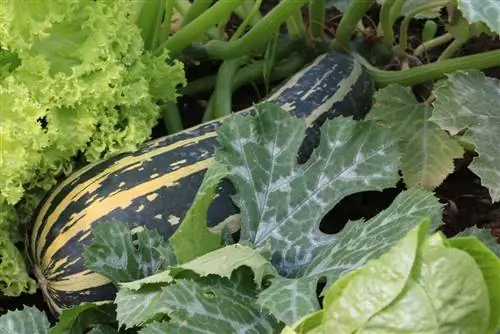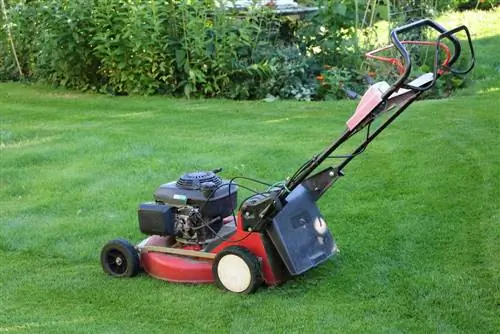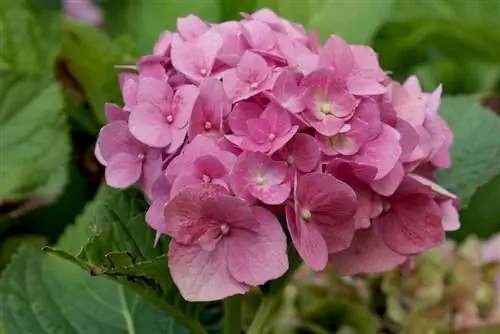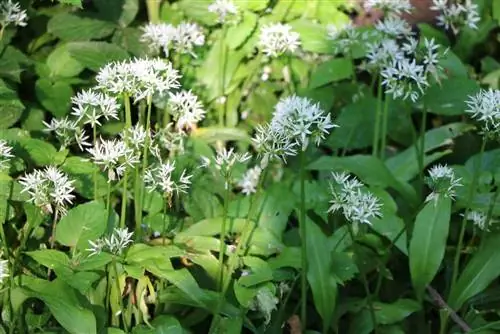- Author admin [email protected].
- Public 2023-12-17 03:39.
- Last modified 2025-01-24 12:45.
The zucchini (Cucurbita pepo) should not be missing in any garden: Hardly any other vegetable plant continuously produces new fruits over several months. A family of four is already well supplied with one or two well-developed plants - each one produces 20 or more of the tasty zucchini. If you planted young plants in the bed in May, you can harvest until frost.
Harvest time between June and October
The heat-loving zucchini are planted directly into the bed as young plants after the Ice Saints - around mid to late May. A handful of fresh compost and horn shavings get you off to a good start. You can harvest the first fruits after just six to eight weeks; even earlier if the weather is consistently warm and sunny. If the plant remains he althy and is regularly supplied with water and fertilizer, it will tirelessly produce tasty fruits well into October. So that it doesn't die beforehand, you should give the zucchini plenty of space - at least three square meters should be planned, because the plant gets huge as it gets older.
Tip:
The zucchini feels particularly comfortable on a classic, layered raised bed. The rotting process inside the bed provides a pleasant warmth, which allows the zucchini to thrive even better. In addition, the heavy feeder is adequately supplied with nutrients on a freshly layered raised bed, even without additional fertilization.
Can you cut off the leaves?
Given the sheer size, many a zucchini gardener gets into trouble: the large leaves and long shoots put pressure on neighboring plants or deprive them of the sun. In this case, you can remove some particularly annoying leaves. However, keep in mind that the plant draws its strength from the leaves - it is these that make the vital photosynthesis possible. Ergo, the more leaves you remove, the plant loses energy. This in turn is also noticeable in the harvest, which noticeably declines. However, you should definitely cut off diseased leaves that show signs of powdery mildew or other diseases. These must be removed and disposed of as quickly as possible (not in the compost!) to avoid further spread and infection.
Harvest zucchini as young as possible
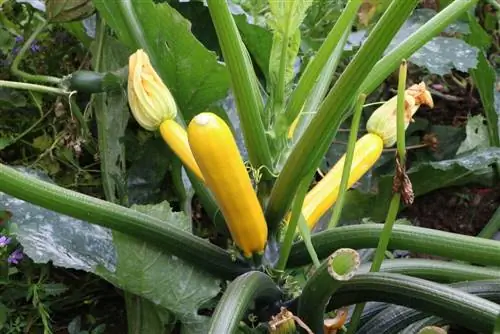
The fruits of the zucchini should be harvested as young as possible. A length of ten to 15 centimeters is ideal, because then the zucchini are still tender and aromatic in taste. Spherical varieties should have a maximum diameter of around seven to ten centimeters. The older and larger the fruits become, the more they lose their taste and consistency. Additionally, the longer you let each one grow, the fewer fruits the plant will produce. Harvesting when young ensures that the harvest is more plentiful. The reason for this phenomenon lies in the plant's energy balance: the individual fruits also need to be supplied with energy; the more, the bigger they are. Harvesting releases new energy for the plant, which it then invests in producing new fruits.
Cut or twist the fruit?
It is usually advisable to cut off the ready-to-harvest zucchini with a sharp knife so that a piece of stem, up to five centimeters long, remains on the fruit. This stem ensures that you can store the zucchini for longer and is therefore useful. However, cutting it off injures the plant and provides an entry point for various pathogens. In any case, zucchini plants are particularly susceptible to fungal and viral diseases, which is why you should prevent them. So it's better to twist the fruit carefully instead of cutting it off: this way the injury and therefore the risk of infection remain smaller.
Tip:
Once a zucchini plant has started producing fruit, you can harvest several times a week. A continuous harvest stimulates the plant to produce new flowers and fruits.
Store freshly harvested zucchini properly
After harvesting, young zucchini in particular should not be stored for more than a few days: the smaller and more tender the fruits are, the less storable they are. This is the only advantage of large fruits, they can be stored much longer. When storing fresh zucchini, please note the following instructions:
- Do not store zucchini in the refrigerator
- do not store at temperatures below 10 °C
- Do not store zucchini near apples, pears or bananas
- the ripening gas ethylene causes them to rot quickly
It is best to leave the zucchini in a dark and not too warm place in a basket or similarly airy place. They last up to 12 days, only very young specimens can be used up more quickly.
Caution: Do not eat bitter-tasting zucchini
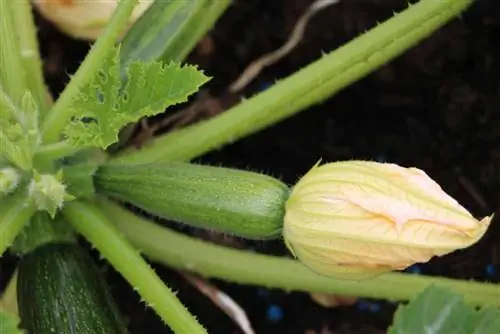
If you notice a bitter taste in your zucchini meal, you should stop eating these zucchini. A strong bitter note is an indication of cucurbitacin, a poison that in rare cases can cause fatal poisoning. Cucurbitacin occurs naturally in many cucurbits, but has been bred from modern garden varieties. Sometimes a plant still develops this toxin: This is especially the case if you used seeds from your own production to grow the young plants.
Tip:
Do not grow any other cucurbits near zucchini
Pumpkin plants are closely related to each other and therefore pollinate each other. If you want to avoid zucchini plants contaminated by toxic substances, you should especially avoid growing ornamental pumpkins at the same time. However, varietal purity is also lost when other pumpkin plants are grown: For the production of seeds, other pumpkin species and varieties should therefore be avoided and you should only grow one type of zucchini.
Harvesting flowers
Not only the fruits, but also the large, bright yellow flowers of the zucchini are edible and can therefore be harvested. However, only use the male flowers; these can be recognized by their size and the stem or fruit base. The best time to harvest the zucchini flowers is shortly after they have opened - then the delicate petals are particularly aromatic. Cut or twist off the flower including the stem or fruit base. The flowers can only be stored for a short time and should be processed the same day.

